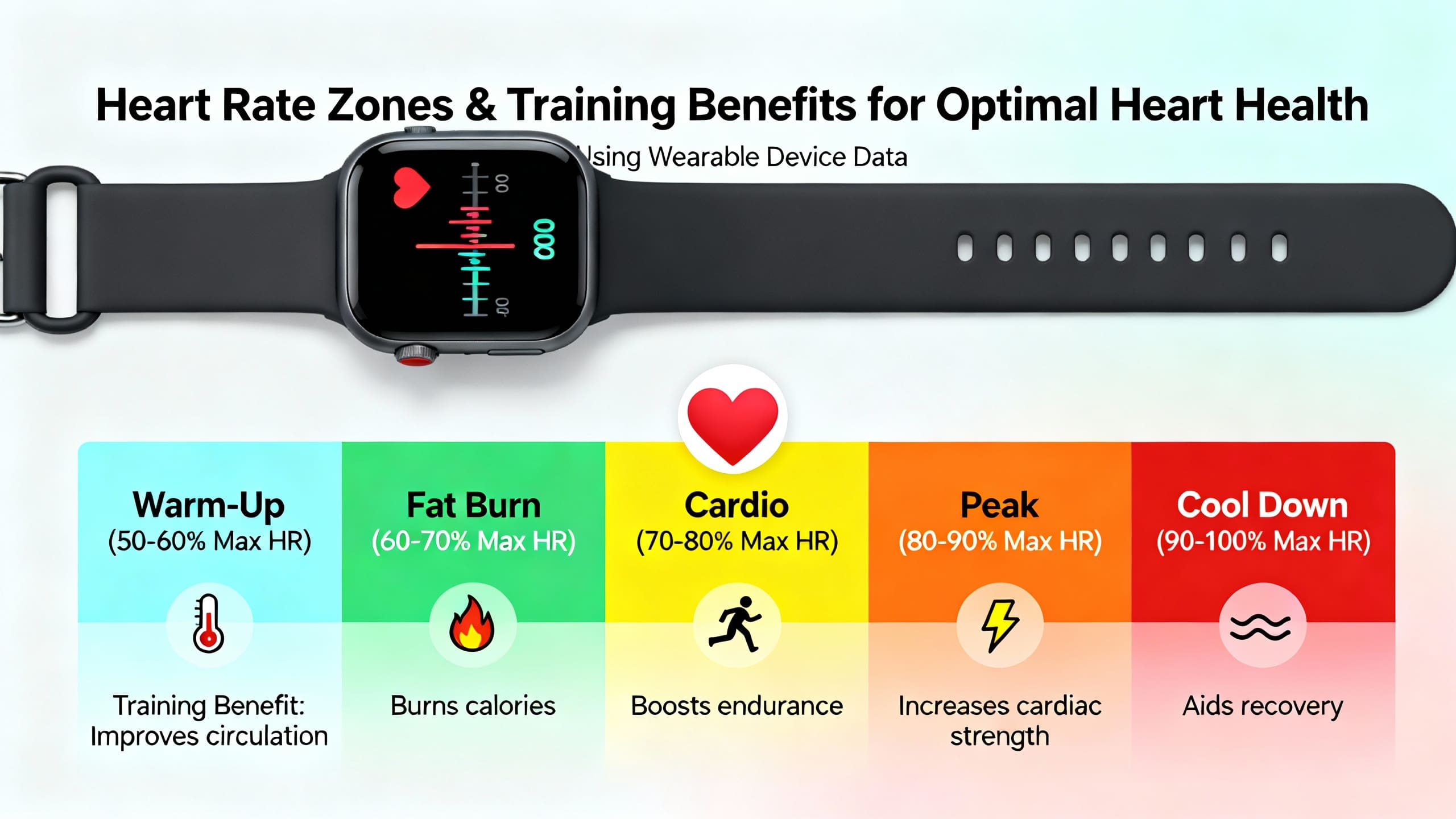Introduction
Understanding heart rate zones, lactate threshold, and the effective use of wearables is essential for anyone seeking better heart health, an optimal heart, and improved exercise results. Integrating tools like wearables with knowledge of HR zones empowers you to design a training plan that maximizes fitness gains, optimizes cardiovascular outcomes, and dramatically reduces your risk of overtraining—all while favoring long-term heart health. In this guide, we’ll unravel the science and practice behind HR zone models, the role of the lactate threshold, and how to leverage technology for an optimal heart.
What is HR Zone Training, Lactate Threshold, and Wearable Tech?
Heart rate (HR) zone training is a method of structuring workouts based on specific intensity ranges, each targeted for unique fitness benefits and heart health goals. Typically, HR zones are determined as percentages of your maximum heart rate (MHR) or, even more accurately, tied to your lactate threshold—the point at which lactate rapidly accumulates in your blood, signaling intense anaerobic exertion Meyer et al., 2005, Seiler & Kjerland, 2006. Recent advancements in wearables—such as smartwatches and heart rate straps—offer real-time data, allowing for personalized adjustments that promote both optimal heart performance and safety during activity.
Benefits and Outcomes in Heart Disease
Training within appropriate HR zones offers wide-reaching benefits for heart health, including the reduction of high blood pressure, improved vascular elasticity, and decreased risk for atherosclerosis Garber et al., 2011. By using the lactate threshold as a guide, athletes and health-focused individuals avoid overtraining and unnecessary cardiac stress, optimizing oxygen delivery and heart efficiency Laursen & Jenkins, 2002. Wearables help recognize signs of cardiovascular strain early, enable more precise training load adjustments, and foster long-term gains for an optimal heart Cadmus-Bertram, 2017.
Research Insights
Recent scientific evidence highlights that tailoring training intensity to HR zones, especially grounded in lactate threshold metrics, enhances heart health outcomes. A systematic review in the Journal of Physiology summarized that athletes monitoring their HR zones and adjusting intensity based on real-time data saw improved aerobic capacity and reduced cardiac risk factors Seiler & Kjerland, 2006. Another study showed that tracking and balancing exercise intensity prevents overtraining and supports sustained cardiovascular gains Laursen & Jenkins, 2002. Additionally, wearables have been confirmed as valid tools for self-monitoring, supporting heart health strategies in both clinical and general populations Cadmus-Bertram, 2017.
Practical Applications
To use HR zone training for optimal heart health, determine your maximum heart rate (MHR) using formulas or testing, then calculate zones (e.g., 50-60% MHR for moderate activity, 70-85% for vigorous). Incorporate interval sessions targeting different zones to condition both aerobic and anaerobic systems Garber et al., 2011. Use lactate threshold tests (available at some sports clinics or with advanced wearables) to personalize training limits.
Most wearables, like heart rate monitors or smartwatches, simplify this process by tracking your HR in real time, alerting you if you approach possible overtraining or exceed safe cardiovascular limits Cadmus-Bertram, 2017. These methods benefit both beginners and advanced athletes, ensuring progress while protecting heart health.
Risks & Limitations
While HR zone training and wearable tech offer powerful benefits for achieving an optimal heart, there are limitations. Maximum heart rate formulas are population estimates—individual values may differ notably Meyer et al., 2005. Not all wearables ensure medical-grade accuracy, especially at high intensities or in certain populations.* Over-reliance on tech may cause some users to ignore physical cues of overtraining, emphasizing the need for a balanced approach Cadmus-Bertram, 2017. As with any new regimen, consulting a healthcare provider is vital, especially for those with heart disease or risk factors.
Key Takeaways
- HR zone training, aligned with lactate threshold, directly supports heart health and achieving an optimal heart.
- Wearables provide actionable, real-time data to help prevent overtraining and promote the best cardiovascular outcomes.
- Structuring workouts by HR zones helps reduce cardiac risk, improve fitness, and individualize progress.
- Safe application and attention to body signals, alongside wearable data, are essential for maximal benefit and safety.
Frequently Asked Questions
1. What are heart rate zones and why are they important for heart health?
Heart rate zones are intensity ranges based on a percentage of your maximum heart rate. Training within these zones enhances cardiovascular efficiency and reduces heart disease risk Garber et al., 2011.
2. How does lactate threshold impact my training plan?
Your lactate threshold marks the shift to intense, anaerobic exercise. Training near, but not beyond, this point optimizes endurance and heart health Laursen & Jenkins, 2002.
3. Can wearables prevent overtraining and support an optimal heart?
Yes, wearables track your heart rate to ensure you stay within safe, productive zones, promoting optimal heart outcomes and reducing overtraining risk Cadmus-Bertram, 2017.
4. Are there any risks to HR zone-based training?
Risks include inaccurate HR readings from devices and ignoring body cues. Awareness and consulting professionals reduces adverse outcomes Meyer et al., 2005.
Suggested Links
- American Heart Association: Understanding Your Target Heart Rate
- NIH: Physical Activity and Cardiovascular Health
- PubMed Search: Heart Rate Zones and Cardiovascular Outcomes
Conclusion
Mastering HR zones, understanding your lactate threshold, and embracing wearables are powerful tools for achieving optimal heart health. By developing a data-driven, individualized training plan and respecting both technological insights and your body’s feedback, you can unlock sustainable improvements in cardiovascular health and prevent heart disease. Take charge of your heart health—adopt smarter training habits today and consult a healthcare professional for personalized guidance.



